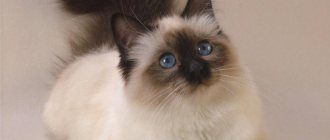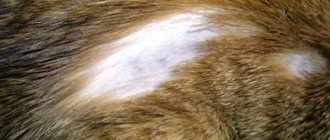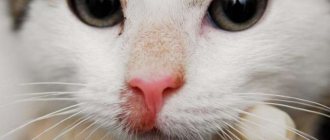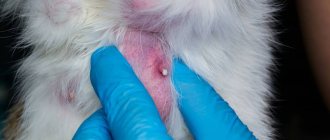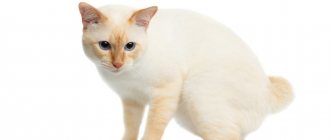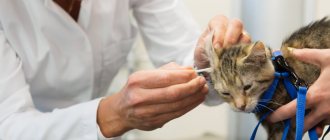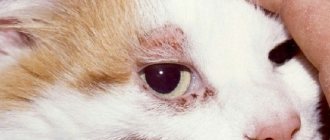Ringworm in cats is a fungal infection of an animal. What is the cause of the disease? In the first place is infection. Reduced immunity, allergies, and viruses are also prerequisites for the disease. More recently, 20 years ago, even 10 years ago, the disease was considered incurable. Pets were euthanized. Fortunately, today lichen in cats and kittens can be treated. The disease is contagious; it can infect other animals and, which is very unpleasant, people.
It is necessary to be vigilant and at the first signs of deprivation (we will talk about them a little later) not to self-medicate, but, having grabbed your pet, come to an appointment with a veterinarian for an accurate diagnosis. Many people encounter this for the first time, panic, search on forums, ask friends what to do? Yes, you can listen to advice, but! you should calm down and come with your cat to a doctor's consultation. By being patient and receiving the necessary treatment methods, you can help your pet recover.
In the article we will talk about the types of ringworm, its symptoms, and will dwell in more detail on the treatment of ringworm and prevention.
Types of lichen
There are several types of lichen. They differ not only in external signs, but are also treated differently.
- Lichen planus;
- Pink or herpes zoster;
- Ringworm or eczema;
- Pityriasis versicolor;
- Ringworm.
Lichen planus is characterized by the appearance of red blisters on the cat's skin. It itches constantly, the blisters burst, causing severe itching. Red bubbles appear in the groin, abdomen, and on the bends of the joints. The mucous membranes are affected. This type of lichen in a cat signals that not everything is ok with the immune system. The good news is that this shingles is not spread to other animals or people.
Pityriasis rosea in a cat is a sign of a viral infection. How does it manifest itself? Pink spots ranging in size from 1.5 to 2 cm appear on the animal’s body. The cat itches and the skin peels off. Then the stain becomes crusty. Ringworm usually goes away on its own. During the period of exacerbation, the animal should not be washed or released into the sun. You need to take care of his healthy diet. There is no consensus in the scientific world about whether pityriasis rosea in cats is dangerous or not.
With weeping lichen, red bubbles appear, filled with liquid, which are very painful. Ringworm or eczema is rare. The disease can be caused by a malfunction in the immune system, the presence of parasites, allergies to food and detergents. This type of lichen is not contagious.
Let's look at what pityriasis versicolor (varicolored) lichen in cats is. This type of lichen is very contagious for humans and is easily transmitted to other animals. It is also called “sun fungus” and “beach lichen”. Oval spots of pink, brown, pale yellow color appear on your pet's body, growing very quickly. Pityriasis versicolor requires long-term and serious treatment.
Symptoms
Ringworm is one of the most dangerous types of fungal skin infections. Without treatment, it can lead to baldness and even death of the cat. At the initial stage, a rash appears on the skin. However, in long-haired cat breeds, the rashes are very difficult to notice. The early stages of lichen can also be determined by changes in the pet's behavior. The cat becomes anxious and restless, constantly itches and loses its appetite. As the fungus spreads, the animal's hair falls out and scales appear on the skin.
With pityriasis versicolor, brown, yellow or pink spots appear on the animal's skin. Most often they are localized on the paws, head or neck. These rashes are subtle and may periodically disappear and then reappear. Pityriasis versicolor is usually not accompanied by severe itching.
Pityriasis rosea most often appears in kittens or older animals. In cats, small pink spots appear on the skin, reminiscent of allergic rashes. These manifestations last about 6 - 9 weeks and then disappear. However, spots may reappear when immunity decreases.
What to do if you notice signs of lichen in your cat? Only a specialist can treat and identify such pathologies. After all, lichen is very easy to confuse with other types of skin diseases. You need to take your pet to the veterinarian as soon as possible. The doctor will examine the skin using a Wood's lamp. If you direct the light of the device to the affected area, a bluish or greenish glow appears when the lichen occurs. If necessary, scales are scraped from the area of the rash and sent for microscopic analysis.
Ringworm
Now let’s take a closer look at what ringworm is in a cat. It is one of the most dangerous and common types of lichen. What is the danger and insidiousness of this disease? The fact is that the incubation period for lichen in cats can last from several days to several months. Other animals and unsuspecting people become infected. It is especially dangerous for long-haired breeds, since the hair prevents the first signs of the disease from being seen. How to treat ringworm in cats will be discussed a little later.
Let's consider what is the causative agent of ringworm? These are dermatophyte molds. There are two forms of ringworm:
- - microsporia;
- - trichyphytosis.
- What happens with microsporia?
- - hair fragility appears at the skin level;
- - wool hair is easily pulled out.
When hair falls out, other animals and people become infected with fungal spores.
Trichophytosis, the second form of the fungus, is very rare. With this type of ringworm, baldness appears only in the head and neck area.
There are three forms of the disease:
- -superficial;
- -deep;
- -atypical.
With a superficial and atypical form of ringworm in cats, for a long time it is impossible to notice that the disease process has already begun.
It is very important to identify the disease at an early stage; the method and time of treatment for your pet will depend on this.
Who is at risk and can get ringworm?
- -most often these are small kittens;
- - long-haired breeds (genetically predisposed to such diseases);
- - cats with malignant processes in the body;
- - cats infected with parasites;
- -young cats up to one year of age.
One of the most pressing and exciting questions is how is lichen transmitted from cats? Unfortunately, ringworm is contagious to humans. You love your pet, pet it, pick it up. Yes, usually upon contact the process of lichen infection occurs. This happens especially easily if there are scratches, wounds, or abrasions on your hands. You can become infected by dandruff, scales, and hair falling from a cat. Children can become infected very easily while playing in the sandbox. Your home, bowls, rugs, combs, etc. are contaminated. Fungal spores are very stable and viable. Will the person get sick or not? It depends on the type of lichen and the person’s immunity. Children and people with weakened immune systems are at risk.
Prevention of feline lichen
Deprivation in a cat can be avoided thanks to preventive measures:
- the house must be clean, and the cat’s sleeping area must be disinfected regularly;
- furniture surfaces are wiped with a bleach solution once a week;
- It is not advisable for the pet to have contact with stray cats and dogs;
- The cat's diet must be balanced and contain all important vitamins, micro- and macroelements.
- Preventive measures also include regular examination by a veterinarian, who can immediately detect the first symptoms of an incipient disease and prescribe adequate treatment.
global $ads_google; //data-ad-slot=”2475549904″ $ads_google = empty($ads_google) ? false : true; ?> if ($ads_google == false) {?>
$ads_google = true; ?> } ?>
As already mentioned, the disease is more often contracted by animals with weakened immune systems, as well as kittens and older cats. This is a risk group that requires more attentive care and quality nutrition.
How to avoid getting shingles from a cat?
Firstly, do not have contact with stray animals and do not allow children to do this. After walking, be sure to wash your hands. If you have a cat, take it to the vet to have it checked for ringworm. Clean the apartment regularly using disinfectants. Be sure to treat your cat for parasites. It is important to provide your pet with a nutritious diet; this helps maintain its good condition, increases immunity, and therefore the skin’s resistance to infections.
Now let’s look at where cats get lichen from? Your pet can become infected through contact with a sick animal. And even without communicating with one, yours can become infected simply by walking in the country. Ringworm spores can be found on the soil. Sometimes you yourself are the cause of your absolutely domestic furry's illness. The fact is that you can bring fungus into your home on clothes, shoes, and things. Sometimes small children infect their pets. The child stroked a cute cat on the street and, when he came home, stroked his own. And that’s it, contact happened.
What can be observed with all types of lichen in cats:
- - hair falls out;
- - the skin becomes inflamed and peels;
- - areas of the skin become inflamed;
- - severe itching appears;
Other types of ointments
In addition to antifungal drugs, there are other treatments for lichen in cats. These include ointments based on sulfur and other chemical compounds:
- Sulfuric ointment. When applied to the skin, sulfur is converted into sulfides and pentathionic acid. These substances have a detrimental effect on fungal spores and also promote wound healing.
- Sulfur-tar ointment. Birch tar enhances the healing properties of sulfur. It has antipruritic and wound healing properties.
- Sulfur-zinc ointment. The antifungal effect of sulfur is complemented by the anti-inflammatory properties of zinc.
- Sulfur-salicylic ointment. This drug has a weaker antifungal effect, as it contains a small amount of sulfur (2%). But it contains salicylic acid, which relieves inflammation and promotes skin regeneration. This type of ointment is recommended for use in combination with other antifungal agents.
- Ointment "Yam". In addition to sulfur, this product contains birch tar, salicylic acid, zinc and turpentine. The drug destroys fungal spores, relieves inflammation and promotes skin healing.
All varieties of sulfur ointments can be used to treat ringworm in cats. In the photo you can see how the drug is applied to the skin.
It is very important to treat not only the rash itself, but also the area around it. These ointments do not cause side effects even when applied to large areas of the skin.
How to identify ringworm in a cat at home?
- -one of the first signs that should alert you is that the cat scratches itself often, eats poorly, and does not behave as usual. What happens, what should you pay attention to, how does lichen begin in cats?
- - round flaky spots appear. In some cases, spots appear all over the body. Ringworm often appears in cats on the ears, paws, and face. It all depends on the specific pathogen;
- - crusts form at the spots;
- - hair falls out;
- - your cat itches a lot, often chews and scratches spots;
- - scabs appear along the spine;
- -spots expand and take on an oval shape;
- - in places where the rash appears, the hair thins and the hairs become sparse;
- - the spots grow, if treatment is not started, your pupil will die.
Briefly about the atypical form of ringworm. The fact is that the signs of lichen described above in this form of the disease are absent or not clearly expressed. The disease proceeds unnoticed, since only individual hairs are affected. This is the danger of this disease. The owner does not suspect anything, since he does not see signs of infection, does not take any measures for a long time, and the disease develops.
Symptoms
The symptoms of ringworm are easy to notice visually – the animal’s skin itches and looks damaged
The first signs of the disease are itching and damage to the coat. But each type of lichen has its own manifestations. Microsporia is predominantly asymptomatic. In rare cases, areas with scales and broken hair form on the skin of the head, tail and limbs. In cats with weakened immune systems, microsporia takes an atypical form. It is characterized by the following manifestations:
- formation of tubercles on the skin;
- the appearance of wounds, scabs, dandruff, severe itching. The animal begins to shed heavily;
- the skin becomes covered with pustules and papules. At the same time, scales do not appear and hair does not fall out.
Signs of trichophytosis appear 7–40 days after the cat comes into contact with the source of infection. This form in most cases affects the skin of the neck and head, and is less common on the paws and tail. Trichophytosis can be recognized by the following signs:
- severe itching;
- the presence of crusts and scales;
- the formation of tubercles, which at the beginning of the disease are small in size. As it develops they increase;
- the appearance of spots;
- alopecia – baldness of individual areas, which are subsequently covered with plaque;
- erythema - redness of the affected areas.
Symptoms of lichen visually resemble signs of other diseases. It can be confused with an allergic reaction, flea dermatitis, cat acne, and symmetrical alopecia.
Important! The diagnosis can be confirmed or refuted only after conducting research in a veterinary clinic.
How to determine if a cat has lichen or not?
If you suspect that something is wrong with your cat, do not delay visiting the veterinarian. This will save your time, nerves, and money on treatment. Skin diseases are mostly similar to each other. Even an experienced specialist will not be able to determine by eye what is wrong with your animal? To determine an accurate diagnosis, there are methods such as instrumental and laboratory tests. Using these methods, it is determined that your pet has allergic dermatitis or contagious ringworm.
Initially, the doctor examines your cat, interviews you, if there is a medical record, studies it. Then, after the examination, the examination begins.
- Your pet is scanned under a Wood's fluorescent lamp. Under a Wood's lamp, a cat's lichen glows green. This method is not accurate, because harmless microbes can glow and, conversely, pathogenic microbes do not glow.
- The next method is to scrape the skin or affected hair and examine it under a microscope. It's called trichoscopy. The result is also fast, but not one hundred percent. It is not always possible to detect a fungal infection, but this does not mean that the disease does not exist.
- Sowing a culture of a pathogenic fungus in a nutrient medium is the most accurate and reliable way to determine lichen. To do this, collect the crust and scales, which are placed in a Petri dish. After a certain time (you need to wait about three weeks to get the result), a diagnosis is made. This method is used if the disease has not been cured for a long time. The analysis helps you choose the right medications to cure your cat of lichen.
- Additionally, a blood test is taken. They examine whether your pet has chronic diseases and determine the presence of parasites.
You can undergo treatment in a clinic or at home. Most cats are treated by the owners themselves. How to treat lichen in a cat at home? Follow all the veterinarian's instructions; do not interrupt the course of treatment if you think that everything is already in order. Consult your doctor about what to feed your cat. Mandatory treatment of your home, this will be discussed further.
Determination of ringworm with a Wood's lamp
Most types of lichen caused by fungus are determined using a Wood's lamp. The spores glow under the lamp with a bright green fluorescent color. The cat is brought into a dark room and ultraviolet light is directed at it.
Before the procedure, you should not treat the affected areas with ointments or powders, as this may complicate the diagnosis. The fact is that some medications also glow green when exposed to ultraviolet light.
You should also know that not all types of fungus can be determined using a Wood's lamp. For some species, you will have to take an analysis and do a culture. This method gives almost 100% results, but takes from several weeks to a month, since the spores grow for a very long time.
How to remove lichen from a cat?
Treatment by a professional is the most correct and reliable method of treatment. There are also folk remedies. More on them later.
Treatment for ringworm in cats depends on the severity of the disease, the breed of the cat, its age, immunity, the presence of chronic diseases, and pregnancy. During treatment, different drugs are used. For local treatment - these are ointments, creams, sprays, drops, shampoos. For severe cases of the disease, tablets, vitamins and immunomodulators are prescribed. Vaccines are also used. Now let's look at some of the drugs used in treatment.
For example, Clotrimazole for lichen in cats. During the initial treatment of deprivation in a cat with Clotrimazole, the veterinarian gives her an injection and treats the infected areas with the drug. The product is available in the form of gels, solutions, creams, tablets, and injections. It is found on sale as Candizol, Amyclone and Fungin.
Veterinarians advise cat owners to have Clotrimazole ointment in their home medicine cabinet; they also use it for inflammatory processes. Scheme for treating ringworm in an animal with Clotrimazole ointment: lubricate the infected areas with ointment two to three times a day, applying a thin layer, gently rubbing. Do it within a week. Repeat after three to four weeks, lubricate once or twice a day. What to do if the areas are very large? First, wash the affected area with soap and water and dry. Then apply Clotrimazole ointment three to four times daily for three to four weeks.
Terbinafine, a broad-spectrum drug, is also used to treat ringworm in cats. Available in tablets, ointments, creams. Terbinafine ointment is applied in a thin layer to the infected areas once or twice a day. During healing, crusts form on the wounds, which must be removed with a cotton pad moistened with water.
The healing process can last 30 days or more. It all depends on the severity of the disease and the fungus. Very important: do not self-medicate! Anti-lichen tablets for cats are prescribed only by a specialist when the disease is severe, as they have side effects. The doctor prescribes the dosage and regimen of medications.
Now about the vaccine. Abroad (in Europe and America), the lichen vaccine is not used for cats. In Russia, the lichen vaccine for cats is used for both treatment and vaccination. The most common of them:
- Vakderm;
- -Microderm;
- -Polivak TM.
What does the shingles vaccination give? This is an opportunity to protect the animal from infection for a long time. The following must be taken into account:
- -Vaccination from the age of two months;
- -Contraindications – cat pregnancy;
- -The cat must be healthy. If she was sick, then the vaccine can be done after two or even three weeks;
- -10-14 days before the lichen vaccination, you must give an anti-worm tablet. To get rid of skin parasites, bathe your cat with a special shampoo.
- - Conduct a diagnosis for ringworm under a Wood's lamp.
Animals usually tolerate lichen vaccination easily.
There is an opinion that vaccination against lichen is not necessary for cats. Whether to do it or not, you decide for yourself.
The main means of combating ringworm in cats remain antifungal drugs and mandatory hygiene.
Ringworm shampoo for cats must be used in the treatment of the disease. These are special shampoos containing Miconazole, Ketocanazole, Epilconazole. They are usually used twice a week for 5-6 weeks. The most popular of them are Nizoral and Sebozol. You cannot cure your cat of ringworm using shampoo alone. They are used only in complex therapy.
Sulfur ringworm ointment is also used to treat cats. Apply to the affected area, covering another 2-3 cm around 1-2 times a day for a week.
YAM BK ointment is often used in the treatment of lichen in cats. The affected area is treated, covering another 2-3 cm nearby 1-2 times a day. Using a cotton swab or swab, gently rub in the ointment twice a day. Treatment time is from 4 to 10 days.
Reviews about the use of potassium permanganate against lichen in cats differ. Some people find the use of potassium permanganate effective. Yes, in the case of ringworm, the use of potassium permanganate is justified. If an animal has pityriasis rosea, the use of potassium permanganate is prohibited, as it can provoke the appearance of eczema. Wash the wounds with a weak solution of potassium permanganate and lubricate the sores. When treating ringworm in cats, a solution of potassium permanganate and a solution of hydrogen peroxide are often combined. First, drop potassium permanganate and then a drop of peroxide. The procedure is safe and effective.
Ringworm spray for cats is the most convenient remedy used for external treatment of cats against lichen. It is applied to sore spots, lightly rubbing. Repeat 2-3 times a day.
When treating cats with lichen using external means, they must wear a protective collar made in the form of a mouthpiece. Many products are toxic, and this will prevent the animal from licking them.
Quite conflicting opinions exist about the treatment of lichen in cats with iodine. Just look at the forum and read the reviews. Can lichen be treated with iodine? Some argue that it is possible. Others categorically deny. Based on the first statement: it can be cured at the initial stage by lubricating small affected areas 2 times a day. Why not? Iodine causes skin burns.
Antifungal ointments
How to cure lichen in a cat with local remedies? For therapy at home, ointments, gels, drops, sprays and shampoos can be used. These products contain antifungal components.
The most popular antifungal drugs include:
- "Clotrimazole". The active component of the drug is the antimycotic substance clotrimazole. It inhibits the formation of proteins in the membranes of fungal cells. It is recommended to apply the drug to lichen rashes three times a day. The duration of therapy is usually about 1 month. The ointment should not be used on pregnant or lactating cats.
- "Miconazole". The active component of the ointment is miconazole nitrate. This substance acts similarly to clotrimazole. The ointment is applied twice a day. This drug is effective for ringworm and pityriasis versicolor in cats. Treatment takes from 1 to 2 months.
- "Sanoderm". This is a combination drug based on clotrimazole. It also contains betameson (an anti-inflammatory corticosteroid), gentamicin (an antibiotic) and nipagin (an antiseptic). The drug is applied to the affected area twice a day. The drug contains hormones, so it can be used for no more than 4 weeks. If a repeated course of treatment is necessary, then you need to take a break of 20 days.
After applying the ointments, you must put a protective collar on the cat. This will prevent the drug from being licked off. Many topical antifungal agents can be toxic if swallowed.
A relatively new drug is the Imaverol emulsion. Its active ingredient is the antimycotic substance enilconazole. During the entire course of treatment, the emulsion is applied to the affected areas 4 times with an interval of 3 to 4 days. This drug is considered the most gentle remedy, since enilconazole rarely causes side effects.
After just a few days of local treatment for lichen, the itching in cats is significantly reduced, and the scales on the affected areas begin to peel off. 1 - 2 months after using the ointments, the lichen rashes completely disappear.
Folk remedies for treating lichen.
There are also folk remedies for the treatment of ringworm in cats. This is especially true for healing pregnant cats, since many drugs used in treatment are harmful to them and their offspring. The most popular of them:
- -warm mixture of aloe juice and olive oil (1:1 ratio). Lubricate the affected areas;
- - treat with iodine solution twice a day;
- - treat wounds with celandine;
- -sprinkle the infected areas with newspaper ash 3-4 times a day;
- – mix lemon juice and olive oil in equal doses and apply warm to sore spots four times a day;
- - decoctions of herbs from valerian, chamomile, burdock, plantain, yarrow, tricolor violet, etc. are used. Herbs are used in combination or separately.
Remember: it is impossible to cure lichen in a cat with folk remedies, since it is a fungal disease. Ointments and preparations are available both in price and in their availability. For treatment to be effective, you must follow all the veterinarian’s instructions.
Other signs of lichen
Ringworm in cats may present symptoms similar to other skin diseases:
- acne, furunculosis;
- fistulas;
- dermatitis with crusts and pustules;
- the animal's fur becomes matted, greasy, and dandruff appears;
- redness and peeling of all skin on the body;
- nail infection with fungus (onychomycosis).
Symptoms of dermatophytosis and dermatomycosis in cats can also appear in an atypical form, looking as if it is fraying of the fur or a bruise.
What to do if your cat has shingles?
- -After the diagnosis has been established and treatment prescribed by a veterinarian, it is necessary to treat your home. It is very good if the animal can be isolated, which is not always possible. No contact with children!
- -Treat a sick pet on special bedding (ideally disposable), wearing disposable gloves and protective clothing. After the procedure, disinfect things.
- – In the house, treat not only the floors, but also the doors, baseboards, corners, cracks, cabinet and upholstered furniture. Carry out wet cleaning with the addition of disinfectants.
- -Wash bed linen regularly.
- – Vacuum the room using disposable bags – dust collectors.
There are a lot of chemical solutions for effective surface treatment, but given their high cost, not everyone can buy them. You can use available tools:
- -A solution of bleach with water in a ratio of 1:10. They wash floors with it.
- -A saturated solution of laundry soap (1:6), also for washing the floor.
- -Solution of medical ethyl alcohol 96% with water (1:10). They treat all surfaces except upholstered furniture. Upholstered furniture is vacuumed.
Prevention
Following these rules will help you avoid getting infected and will save your cat:
- Vaccination of an animal against lichen.
- Never pet other people's cats. Teach your children to do this. Stray street cats are especially dangerous.
- Wash your hands with soap: every time you pet your pet; when you come home from the street; after contact with cat accessories: tray, toys, bed.
- Keep your cat away from dirty outdoor shoes and clothing. Wash your shoes when you get home. Clean your hallway regularly.
- Walk your cat in areas where there are no other animals. Avoid contact with stray animals. It is best to keep your pet in an apartment.
- Isolate a cat infected with shingles from other pets and children for the entire course of treatment.
- At the first indirect signs: restlessness, frequent scratching, take the animal to the veterinarian to make or rule out a diagnosis of ringworm.
Important!
Remember that timely detection of pathology and proper treatment will definitely return your pet to health and will not harm the health of your family!
Vaccination against ringworm
Therapeutic and prophylactic vaccinations against lichen in cats are carried out as part of complex therapy for an animal or for healthy animals as a preventive measure. Vaccinations are given to healthy kittens at the age of 3 months.
Therapeutic vaccination is the most effective modern way to get rid of fungal infections of the skin and fur of cats. Injections are given 2-3 times with an interval of 10-14 days.
Vaccines used in veterinary medicine:
- Polivac TM is a highly effective vaccine based on 8 types of strains of weakened fungi (trichophytin, microsporum). The effect of the vaccine lasts 12-14 months. To develop lasting immunity, a second vaccination is carried out 14 days after the first. Vaccination of healthy cats does not cause complications. After a year, revaccination is carried out.
- Vakderm-F is a drug based on non-living spores of ringworm. The injection therapy product is used simultaneously with topical medications (ointments, sprays). To completely cure an animal, 2-3 injections are enough. For preventive purposes, it is used to vaccinate kittens from 2 months of age and healthy adult animals. The effect of the vaccination occurs after 25-30 days. Vaccination is carried out twice with an interval of 1014 days.
- Microderm is a therapeutic injection veterinary drug with high effectiveness against ringworm. To achieve the result, the medicine is administered to the cat twice with an interval of 10-15 days. The product is characterized by low toxicity. Suitable for preventive immunization.
Important!
Injections against lichen cannot be used in the treatment of pregnant and lactating cats, animals with hyperthermia.
Symptoms of lichen in humans from cats
As mentioned above, ringworm is contagious to humans. Children are infected first, then people with weakened immune systems and allergy sufferers. What happens to a person infected with lichen from a cat?
After infection, the disease may appear from several days to several weeks. Ringworm can appear on the body, nails, and head. Peeling spots appear on the skin, spots grow, and the skin turns red. Round, flaky bald spots appear on the head (the area looks as if someone has shaved it), and grayish spots appear on the nails, which leads to their fragility. Unlike cats, lichen in humans generally occurs without complications. If you discover suspicious, unknown skin diseases, immediately go to a dermatologist.
Causes
Ringworm develops due to infection of skin areas by fungi.
As mentioned, the occurrence of lichen is provoked by the spores of Trichophyton, Microsporum canis and Microsporum qypseum. Fungi live not only on the cat, but also spread to all objects with which it has come into contact. This could be brushes, furniture, bedding, or fallen fur. Fungal spores live for about two years. Infection does not always occur immediately after the appearance of dermatophytes; they may not be detected for several months.
Important! The active development of fungi begins when exposed to a warm and humid environment.
The disease is transmitted through contact with spores that may be located on an infected cat. Fortunately, not all animals are susceptible to this infection. At risk are:
- Kittens under 1 year of age, sick individuals and cats not receiving proper nutrition.
- Animals that have free access to the outdoors. Their immune system is not strong enough to fight off infection.
- Persian cats. The instability of these animals to the disease is explained by the long process of selection, as a result of which they were bred.
Ringworm from infected cats is transmitted not only to other animals, but also to people. Children are especially sensitive to it. A person's nails and scalp are affected.
Prevention of lichen in cats.
- -First of all, it’s cleanliness. Regularly wash and treat your cat's care items with antifungal agents, and change bedding periodically.
- -Bathe your pet in baths with special shampoos.
- -Pay attention to the condition of his skin.
- – Treat your home with disinfectants.
- -Limit, or better yet eliminate, contact with other animals.
- -Provide your pet with a balanced diet, including vitamins, to strengthen the immune system.
- -Show your cat to the veterinarian periodically.
If you are reading this article, then you are faced with this unpleasant disease. Don’t despair, help your pet, because her life and health are in your hands. Do not self-medicate. Follow all instructions from your veterinarian. Only you can cure your pet of lichen.
Rules for processing wool
How to cure lichen in a cat? Before applying antifungal agents, you need to carefully trim the hair on the affected areas. After this, you must thoroughly disinfect or throw away the scissors. It is important to remember that ringworm is very easily transmitted to humans, not only through contact with a cat, but also through animal care items.
If you use napkins and cotton swabs to apply medications, the hygiene products must be thrown away immediately. Immediately after processing the wool, you need to wash your hands and then wipe the skin with an antiseptic.
After completing the procedure, it is necessary to carry out wet cleaning with bleach, since there may be contaminated wool particles on the floor. Then you should disinfect the room using a quartz lamp.
Wetting form
Ringworm is a non-contagious disease better known as eczema. The mechanism of development of the disease is unclear. It is often based on allergies, hormonal imbalances, problems with the nervous system, climate, and ecology.
What does eczema look like in pets?
The disease develops according to the following pattern:
- A small hairless swelling appears on the skin, hot to the touch (either a single or multiple lesions are possible).
- Over time, it turns into a small bubble - a papule, filled with liquid.
- The vesicle gets wet all the time and secretes liquid, sometimes with pus. Due to the source of infection, the fur “sticks together” and looks unsightly.
What to do if your cat or dog has eczema?
If you notice symptoms of eczema in cats and dogs, take zinc ointment for treatment. This is an effective drug for eczema in dogs, which dries wounds, disinfects, and accelerates skin regeneration. You can also use Yam ointment.
Pink (shingles)
Pityriasis rosea is another skin disease of unknown origin. There are suggestions that it is inherited, has an allergic basis, or is caused by an unknown virus. Most doctors believe that the pathology is harmless, but some veterinarians disagree.
How does skin disease manifest in pets?
Externally, the disease resembles an allergy - small and large pink spots appear. They are flaky in the center, smooth at the edges. The pathology itself is not dangerous, but if bacteria gets into the wound, purulent inflammation is possible.
